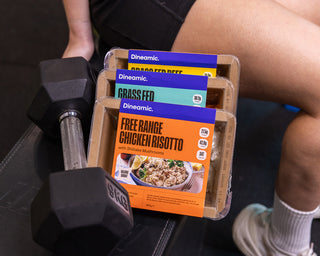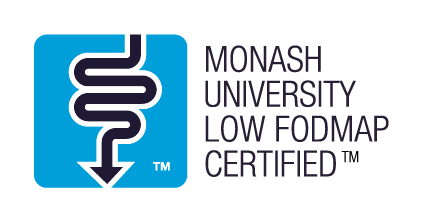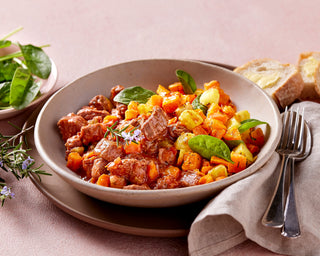Believe it or not, there are more than 100,000 times as many microbes in your gut than there are people on Earth. And yet most of us barely give our guts a second thought—until something goes wrong.
Gut health is finally getting the attention it deserves, and with good reason: research shows it's linked to almost every major bodily function. And for 1 in 5 Australians living with symptoms of IBS (Irritable Bowel Syndrome), managing diet is a critical first step toward feeling better.
One common approach? The Low FODMAP diet. If you’re curious about what it is, how it works, and whether it might help, we’ve put together your ultimate guide—including everyday tips, swaps, and our certified Dineamic Low FODMAP meals to make life easier.
What Is a Low FODMAP Diet?
Developed by Monash University in Melbourne, the Low FODMAP diet reduces certain carbohydrates that are poorly absorbed in the gut and can cause symptoms like bloating, cramping, and gas.
FODMAP stands for:
- Fermentable – carbohydrates fermented by gut bacteria
- Oligosaccharides – found in onions, garlic, wheat, and legumes
- Disaccharides – such as lactose in dairy
- Monosaccharides – excess fructose in fruits like apples
- And Polyols – sugar alcohols found in some fruits and artificial sweeteners
When reduced, FODMAPs can ease pressure in the gut and reduce symptoms for people with IBS. But this isn’t a weight-loss diet or a forever plan—it’s typically done in three phases with guidance from a healthcare professional.
The 3 Phases of the Low FODMAP Diet
- Elimination (2–6 weeks) – Remove high FODMAP foods to relieve symptoms.
- Reintroduction (6–8 weeks) – Slowly test FODMAP groups to identify triggers.
- Personalisation – Tailor your diet to your tolerances for long-term balance.
Why Gut Health Matters
Your gut is home to millions of microbes—and over 100 million nerve cells. It’s connected directly to your brain and produces up to 95% of your serotonin, a chemical that impacts sleep, mood, and appetite.
Stress, poor diet, and lifestyle choices can disrupt this ecosystem, but the good news is you can start improving your gut health with simple steps: eat well, move more, and manage stress.
IBS Symptoms: What to Watch For
IBS can range from mildly annoying to seriously disruptive. Common symptoms include:
- Abdominal pain or cramping
- Bloating and excess gas
- Diarrhoea and/or constipation
- Incomplete bowel movements
- Mucus in stools
- Nausea
Important: These symptoms aren’t exclusive to IBS. Always consult a healthcare provider to rule out conditions like coeliac disease or IBD.
Where Are FODMAPs Found?
FODMAPs appear in many everyday foods, including:
- Fruits (apples, pears, watermelon)
- Vegetables (onion, garlic, cauliflower)
- Legumes (lentils, chickpeas)
- Dairy (milk, yoghurt, soft cheese)
- Grains (wheat, rye)
Even low FODMAP foods can cause symptoms if eaten in large amounts or stacked together. Portion size matters.
Low FODMAP Swaps from Our Nutritionist
From Kobe, Dineamic’s resident nutritionist:
- Onion → Leek (use green tops + some bulb)
- Garlic → Garlic-infused olive oil
- Bread → Spelt sourdough (not coeliac-safe, but often gentler)
- Button mushrooms → Oyster mushrooms or canned champignons
- Butternut pumpkin → Japanese/Kent pumpkin
- Honey → Rice malt syrup or brown sugar
- Legumes → Rinse canned chickpeas or lentils (limit to ¼ cup)
- Jarred curry sauces → DIY spice blends with turmeric, cumin, cardamom, etc.
- Jarred pasta sauces → Use canned tomatoes, olive oil, herbs + spices
Eating Out on a Low FODMAP Diet
Dining out while Low FODMAP? Try these tips:
- Call ahead and ask about options
- Go for simple grilled proteins + sides (skip onion + garlic)
- Japanese (sushi, miso) and Vietnamese (pho, rice paper rolls) are often safe
- Opt for gluten-free bases at Italian spots; ask for olive oil-based sauces
Helpful Low FODMAP Resources
- Monash FODMAP App – The original and most trusted resource
- FODMAP Friendly App – Great for product scanning
- FODShop – Online store for low FODMAP foods
Dineamic’s Certified Low FODMAP Meals
We take the guesswork (and the onion) out of it. Our Low FODMAP meals are Monash University certified and designed by chefs and nutritionists to taste great without triggering symptoms.
Explore our:
Your gut will thank you.









